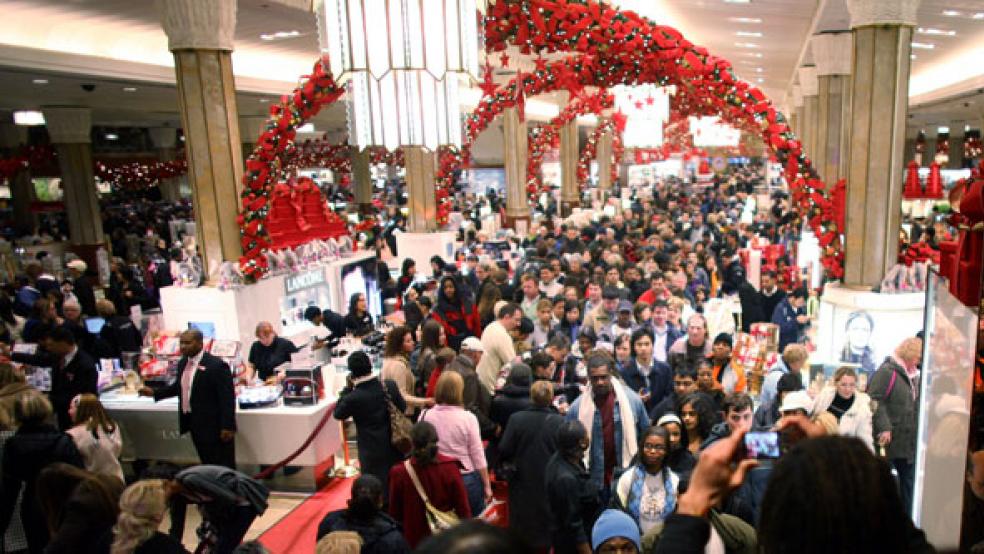The American consumer has transformed certain days on the calendar into orgies of spending and consumption. Halloween now is a $7-billion-dollar business. Super Bowl Sunday has become far more than a day for football hoopla – this year consumers forked over $10.1 billion in food and booze for the game, according to the National Retail Federation. But nothing comes close to national open-your-wallet day, also known as Black Friday. Last year retailers raked in a massive $45 billion in a spending frenzy of snaking lines, middle-of-the-night doorbusters, and extreme post-Thanksgiving familial patience.
This holiday shopping season, as a troubled economy threatens consumer spending, retailers are craving more of the Black Friday drug. In 2010 a handful of major retailers including Banana Republic and Sears, had Black Friday sales lasting several days beyond the Thanksgiving holiday weekend.
The extended celebration goes in the other direction as well: online retail giant Amazon launched its Black Friday page at the start of November. Officially dubbed “Countdown to Black Friday Deals Week,” among its sale offerings are so-called “Lightning Deals,” offering deep discounts within a set period spanning a few hours. For example, the XtremeMac Tango TRX 2.1 Bluetooth High-Fidelity Audio System, which retails for $180, went for $85 during one of these flash sales. As of November 11, it was still heavily discounted at $95.24. In addition, more online retailers are participating in Cyber Monday this year, three days after Black Friday.
Beyond sales on or around Black Friday, the rise of deal-a-day sites, group-buying coupons, discount retailers, and online codes has created more discount deals 365 days a year. So instead of joining the long lines or sleep-deprived crowds on Black Friday, here’s how to take advantage of the sales that happen all year round.
Clicking Coupons
Subscribe to your favorite retailers’ online newsletters for “insider” coupon codes and deals on shipping, as well as private sales only accessible via links embedded in the emails. For example on November 11, Bluefly, an online discount retailer for designer fashion, ran a 12-hour sale offering an extra 30 percent off only to email subscribers, in addition to their regular deals.
Many shopping rewards sites offer loyalty recognition in exchange for shopping on their site and buying items with their network of retailers. Beyond the points racked up for shopping, they also often offer extra incentives such as dedicated coupon codes. One such site, MyPoints, recently began featuring online coupon codes on its homepage and online retailers offering extra perks such as free shipping.
Another popular coupon-aggregation site is Retail Me Not. Its homepage offers publicized coupons to several retailers with links to “clip” the coupons and head to the retailer’s site. Retail Me Not also lets you search specific online retailers to see any available coupons. Site users rate the success of the code and the date it was attempted, so if a code comes up “expired,” you know it’s not you.
Deal-a-Day Keeps Your Wallet at Bay
Deal-a-day sites have had astonishing growth in the past year. Groupon went from 3 million users in January 2010 to 20 million last fall to 115 million today. And hundreds of other companies have jumped on the group-coupon bandwagon. AT&T’s Deal of the Day, LevelUp, GroupCommerce, and Google Offers have all launched recently. Spending on deal-a-day sites is expected to go from $873 million today to $3.9 billion by 2015, according to market research company BIA/Kelsey.
Group-buying sites can be a great way to pamper your mom who lives cross-country or stock up on heavily discounted gift cards and products. Beyond the household name titans like Groupon or LivingSocial, there are several specialized deal sites out there. Suit up your poochie with a bargain from Paws4Deals, or your hipster cousin with a quirky necktie from WildTies.com. Amazon also runs short-time sales on discounts to local classes and services. Plus some blogs run group buy-in deals relevant to their readership. Fashion and culture blog Refinery29 has a sister site, Refinery29 Reserve, that has group deals for fashion and beauty products from independent labels that are often harder to find outside of major metropolitan areas. JackThreads, run by local venue review email newsletter Thrillist, offers tech gadgets and accessories that might appeal to the men on your list. Expiration dates present the biggest caveat; however with many deals, they can usually still be presented as a face value certificate after the deal ends. If not, trade or sell it on CoupRecoup or DealsGoRound.
Discount Retailers: Just a dollar away
Though the downturn has caused familiar brands such as Borders and Steve & Barry’s to shut their doors, one benefit is cheaper retail space. Many value chains opened up in the empty stores.
Big Lots has been using recently vacated retail real estate as part of its business model for decades. Offering deep price cuts on closeout merchandise such as toys, household goods, and clothing, the discount chain is opening 23 new locations in November and posted 6 percent growth during the third quarter. Ross, the discount apparel chain, posted 9 percent year-on-year growth in October and recently opened 12 new locations in Chicago. For the highest-end labels, try the outlet locations of the more upscale department chains—which often have dedicated online stores as well. Through November 20, Last Call by Neiman Marcus’s site is running a sale for an extra 30 to 40 percent off women’s and men’s apparel, shoes and handbags.




